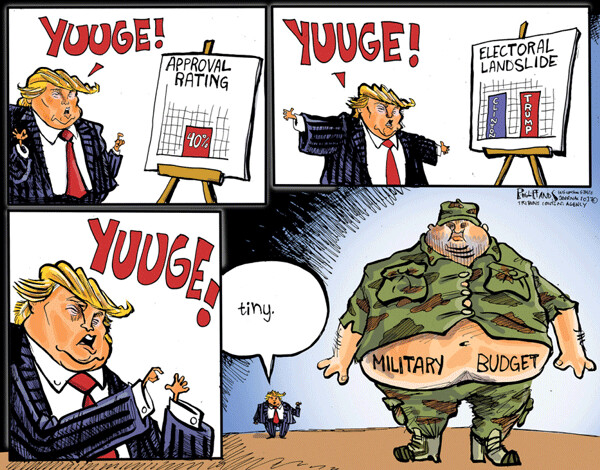White House Lying Goes Ballistic

Back on December 22, 2016, the President of the Electoral College said, “The United States must greatly strengthen and expand its nuclear capability.” This mathematical absurdity was aimed at the “I’m afraid of North Korea” voters who, being afraid, would pay for the expansion — and at the corporate nuclear weapons profiteers who are still drooling over the potential deluge of tax money. But that (lie) was then.
Only 7-and-a-half months later, on August 9, the comb-over in the White Power house tweeted, “My first order as President was to renovate and modernize our nuclear arsenal. It is now far stronger and more powerful than ever before.”
Both of these lies were repeatedly debunked the same day, the first one by the White House’s own website which says the first executive order had to do with “minimizing the economic burden” of patients under the Affordable Care Act or Obama Care.
The second whopper, about the “stronger” nuclear arsenal, was demolished by former State Department adviser for nuclear policy Alexandra Bell who wrote on Aug. 9, “There is no demonstrable difference between our nuclear arsenal now and our nuclear arsenal on Jan 19.”
And the executive director of the Arms Control Association Daryl Kimball told the Washington Post Aug. 9, “The nuclear arsenal is the same as it was the day before Inauguration Day. It consists of about 1,750 strategic nuclear warheads deployed on intercontinental ballistic missiles (ICBMs), submarine-launched ballistic missiles (SLBMs) and strategic bombers — and about 180 tactical nuclear weapons on European bases.”
“Nothing’s happened yet,” says Todd Harrison, director of Defense Budget Analysis at the nonpartisan Center for Strategic & International Studies in Washington. Harrison, also speaking to the Post on Aug. 9, said, “Nothing has really changed in the nuclear arsenal that is available.”
The Post interviewed Jon Wolfsthal Aug. 9 as well. The former director for nonproliferation and arms control in the Obama administration’s National Security Council said, “Any decision that the president … took in January would take years to implement… There have been no visible changes to it.”
But making things up without any basis in fact—climate change is a Chinese hoax, torture works, clean coal is real, etc.—is starting to wear thin. In the face of catastrophic hurricane Harvey, Secretary of State Rex Tillerson said Aug. 28, “The President speaks for himself.”
Six months, 360 months, whatever
The uber militarized Trump administration is pursuing the Obama administration’s plans for a $1 trillion rebuilding of the US nuclear weapons complex. The generals didn’t do it in 6 months, and Obama’s vision was that it would take 30 years to producing 80 new nuclear warheads a year — but that’s the plan.
August 8, the Department of Energy and US Air Force conducted two tests of B61-12 gravity bomb at Tonopah Test Range in Nevada. The test bombs, dropped from an F-15E, demonstrated the warplane’s ability to wage nuclear war. The $12 billion B61-12 program “is progressing on schedule” said Phil Calbos, of the National Nuclear Security Administration. The test included hardware designed by Boeing under contract with the Air Force Nuclear Weapons Center. The NNSA wants the first real B61-12 bomb to be finished in 2022, and intends to ship 180 of them to five underwhelmed “nuclear sharing” NATO partner states in Europe that don’t want them. This, in Calbos’s terms, is progress.
Meanwhile, the Air Force on Aug. 21 granted $349 million in contracts to Boeing, and $329 to Northrop Grumman so the two will compete to replace the Minuteman III nuclear missile arsenal. One of the two contractors is expected to win the $100 billion contract to build over 400 brand new intercontinental ballistic missiles.
WallStreet.com online reported about the Air Force contracts and their part of the overall build-up that, “A review by the Arms Control Association, a nonpartisan, nuclear weapons watchdog, [found] the total 30-year cost of the program could rise to $1.5 trillion.” This is $500 billion beyond what the Obama Administration first proposed.
But then what’s half-a-trillion bucks when considering national security? There is of course no national emergency, or disaster relief, or water damage, or reconstruction anywhere in the country that could possibly be as needy and bereft as the nation’s nuclear capability.